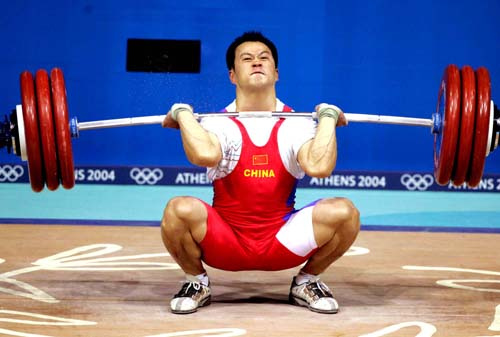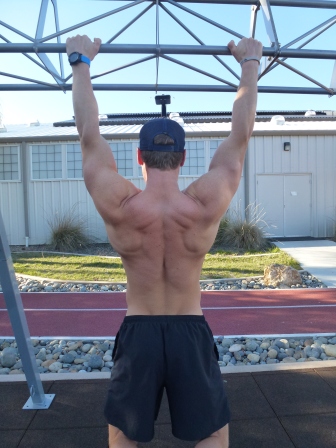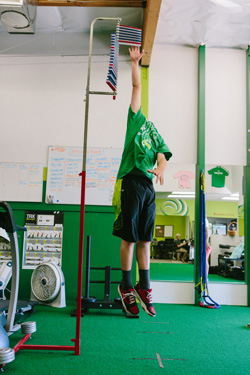Recently, I was teaching a baseball player how to do a back squat. I began explaining the normal cues I give to my athlete, and then something incredible happened. This athlete did something I never imagined seeing. I gave the cue, get your head under the bar and walk back. So he literally tries to stand up with his head under the bar, with his hands assisting it as it rested upon his head. I immediately told him to stop, and then proceeded to crack up with the athlete and his dad. The thing is, he did exactly as I told him to do, just took it very literally.
That is just one example of a common cue gone terribly wrong. As a strength and conditioning coach, we are always providing auditory and physical cues. A common auditory cue is simply telling an athlete to press his or her knees out while benching and squatting. A common physical cue I use is placing a band behind an athlete’s knee and pull forward. Sounds dangerous, but it actually uses PNF to enhance the athlete’s hinge at the hips, a movement pattern most of my athletes have issues with.
Often times, an auditory cue that works with one athlete will not work with the other. (See story above). There are however certain cues, that when applied to exercises across the board, will greatly enhance your performance in nearly every lift.
Cue # 1: Pack Your Scapula.
In my opinion, this is one of the most important cues I can give to my athletes, especially my overhead athletes and those with any underlying shoulder pathologies. Packing your scapula centers the humerus head in your shoulder capsule, improving what we call joint centration. A more centered humerus head will allow for greater shoulder mobility and quality of movement, decrease the amount of stress on the tendons and ligaments within your shoulder, improves the movement of your scapula, and ensures that force is handled properly in your shoulder throughout the given exercise. In other words, it benefits an athlete in all facets of training, sports performance, shoulder health, and life. With that said, it should be clear how this is one of the most important cues I provide to my athletes on a daily basis.
In terms of overall strength, this single cue will make or break how much you can bench, squat, row, etc. I have spoken in depth of the benefit of this cue in upper body exercises in the article (5 exercises to build a big strong back, and How to bench properly). Now I know this sounds made up, but I have truly increased individuals benches by over 40 lbs on multiple occasions in just 12 minutes time. How? By simply teaching the individuals how to engage their lats and pack their scapula while they bench!
Squatting and most lower body exercises also greatly benefit from a pair of nicely packed scapula. Forcefully packing your scapula will turn on your lats, erectors, and other muscles that are responsible for stabilizing and creating a rigid spine. Creating a rigid spine creates a platform to rest the barbell on, ensures your core musculature is turned on (hips included) and prohibits any spinal flexion. This will ultimately increase the total amount of weight you can handle.
Cue # 2 Pack your neck
This cue has been made famous by Charlie Weingraff. In Training = Rehab Rehab = Training, Charlie poses the questions, “Which animal in has the strongest core in the animal Kingdom?” Think about it for a second. You might have come up with a lion, tiger, guerilla, zebra, etc. What about a giraffe? If you did say Giraffe nicely done! You get a gold star! Core strength begins with head positioning.

To use the cue, simply tell your athletes to create a double chin, or straighten out their heads. Both cues work great.
To see this in action, pay attention to your athletes and clients head next time they do push-ups. Instead of letting their head bob around, sag (reach forward), or extend in their cervical spine, cue them into a packed neck, and make sure they keep it throughout the entire set. Mastering this variation of a push up will greatly improve your numbers in every single other lift.
My athletes know this all too well. Most first workouts include this variation of a push up. It Is a great tool to really start educating clients and athletes on to truly activate your core, and begin to explain the concept of joint centration, and how the little cues they will learn are what will allow them to eventually come beasts.
The benefits of the cue do not end with improved activation of your core. Proper alignment of your head will create better alignment throughout your entire spine, as well as improve the positioning of your scapula. You can bet that this cue will improve your squat, bench, dead lift, and overall quality of movement in every other lift.
Cue # 3 Pressing Your Knees Out
Pressing your knees out should be used in every exercises that requires a bilateral stance, in other words standing on two feet. Pressing your knees out improves joint centration of your hips, centering the head of your femur in your acetabulum, allowing for full recruitment of the surrounding musculature of your pelvis. Remember, your core includes your pelvis. To fully use your core, you must be able to stabilize your pelvis.

Stabilizing your pelvis begins with your feet. A stable pelvis will enhance your ability to squat, deadlift, and bench, improve your ability to activate your core, improve the stability of your knees, and the list goes on!
Most people have heard, and used this cue while squatting. But to leave the cue just to squatting would be doing the strength and conditioning world an injustice. Pressing your knees out is a paramount cue when it comes to a heavy bench, improving your position when you do rows, deadlift. I have even had success with this cue for my athletes in unilateral stance, during an inline lunge, and split squat.
Creating a Short Foot
The benefit of this cue is truly noticed at the foot. Stand there feel the tension in your arch. They should feel relatively relaxed. Now stand there, grab the ground with your toes and press your knees out. You should feel your arch become tense, and even see it rise. This is what we call a short foot. Your foot stabilizes your pelvis. Creating a short foot is just the way to create the needed stability.

This in itself is one reason I love to have my athletes spend time training barefoot. It’s harder to create a short foot when you are always wearing sneakers and don’t have full contact with the floor! Being aware, and understanding the little cues, is one reason I believe I have had some huge gains with athletes this summer.
Conclusion
The three cues mentioned above have the ability to completely change the amount of weight you can handle, the gains your can make, and improve your quality of movement. When applying them, take your time. At first they will feel uncomfortable. This is good because it means your breaking the old habits. Stay the cause and trust in the cues. Faster 60’s, higher verticals, harder swing, faster balls, and heavier lifts are right around the corner!
Have a strong day!


